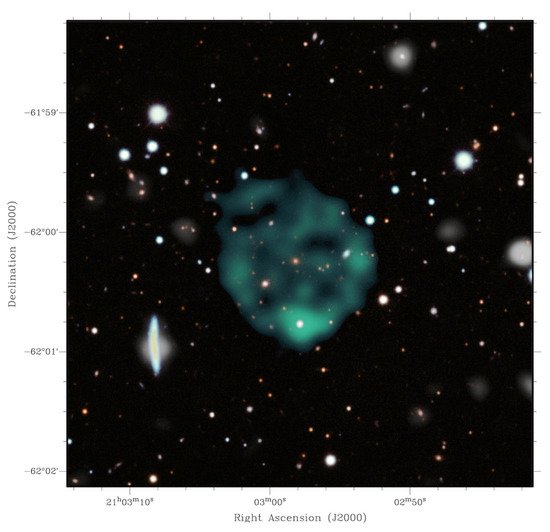You're using an outdated browser. Please upgrade to a modern browser for the best experience.
Please note this is a comparison between Version 1 by Peter Macgregor and Version 3 by Camila Xu.
Odd Radio Circles (ORCs) are unexpected faint circles of diffuse radio emission discovered in recent wide deep radio surveys. They are typically about one arcmin in diameter, and may be spherical shells of synchrotron emission about a million light years in diameter, surrounding galaxies at a redshift of ∼0.2–0.6. Here we study the properties and environment of the known ORCs.
- Odd Radio Circles
- galaxy
- ASKAP
1. Introduction
Odd Radio Circles (ORCs) are recently discovered circles of diffuse steep-spectrum radio emission with no corresponding diffuse emission at optical, infrared, or X-ray wavelengths. The first three ORCs were found [1] in the Pilot Survey [2] of the Evolutionary Map of the Universe [3], using the Australian Square Kilometre Array Pathfinder (ASKAP) [4]. A fourth was found [2] in data from the GMRT [5] and a fifth was found, also in ASKAP data, by Koribalski et al. [6]. Figure 1 shows an ASKAP image of the first ORC to be discovered.

Figure 1. The ASKAP image of ORC1, adapted from Norris et al. [1]. The resolution is 11 arcsec, and the rms sensitivity is 25 μJy/beam, enhanced to show faint features, particularly the internal structure or “spokes” of the ORC. Radio data are shown in green, and the background optical image is taken from the Dark Energy Survey DR1 [8]. For the latter, the DES bands g, r, i, and z were assigned turquoise, magenta, yellow, and red, respectively, and combined using GIMP. The optical/NIR image and the radio image were then combined using a masking technique. Image credit: Jayanne English.
The ORCs superficially resemble supernova remnants (SNRs), but their Galactic latitude distribution is inconsistent with that of SNRs [1]. Similarly, other explanations involving known classes of objects (e.g., starburst rings, gravitational lenses, etc.) have also been shown to be inconsistent with the data [1]. Instead, we are forced to search for other explanations for this phenomenon.
Of the five known ORCs, three are single, and share similar parameters, and are shown in Figure 2. At the centre of each of the three single ORCs, there is a galaxy visible in optical wavelengths (see Figure 2). The probability of this happening by chance is so low as to be extremely unlikely [7]. We therefore call this galaxy the “host galaxy” of the ORC. The properties of the three single ORCs are summarised in Table 1.
Norris et al. [7] argue that the rings of emission represent a spherical shell of synchrotron emission surrounding the host galaxy, and consider two hypotheses for the origin of this shell:
-
it is a spherical shock wave from a cataclysmic event in the host galaxy, such as a merger of two SMBHs;
-
it is the termination shock of a starburst wind from past starburst activity in the host galaxy.

Figure 2. (Left) The ASKAP radio image of ORC1, adapted from Norris et al. [1]. The contours show the radio data (at 45, 90, 135, 180, 225, and 270 μJy/beam) overlaid onto a DES [8] 3-color composite image; DES gri-bands are coloured blue, green, and red, respectively. (Centre) The GMRT radio image of ORC 4, adapted from Norris et al. [1]. The contours show the radio data (at 150, 250, 400, 600, and 800 μJy/beam) overlaid onto a SDSS 3-colour composite image; SDSS gri-bands are coloured blue, green, and red, respectively. (Right) The ASKAP radio image of ORC5, adapted from Koribalski et al. [6]. The contours show the radio data overlaid onto a DES 3-color (grz) composite image. The dark red contour is at 65 μJy/beam and remaining contours are at 90, 120, 170, 220, 270, 400, 600, and 800 μJy/beam. The green ellipse shows the size of the synthesised beam.
Table 1. Properties of the three single ORCs.
| Short Name | IAU Name | RA (deg) J2000 | Dec (deg) J2000 | Host Galaxy | Redshift |
|---|
| ORC 1 | ORC J2103-6200 | 315.74292 | –62.00444 | WISEA J210258.15–620014.4 | 0.551 |
| ORC 4 | ORC J1555+2726 | 238.85272 | +27.44271 | WISEA J210258.15–620014.4 | 0.457 |
| ORC 5 | ORC J0102-2450 | 15.60208 | −24.84392 | WISEA J010224.35–245039.6 | 0.270 |
